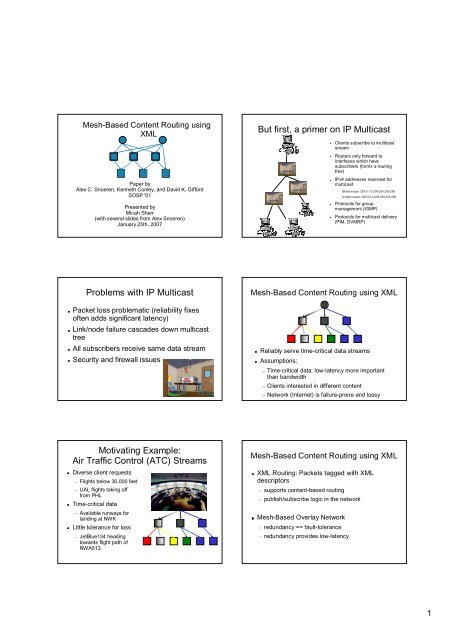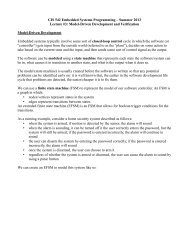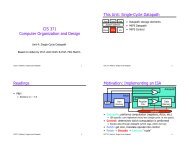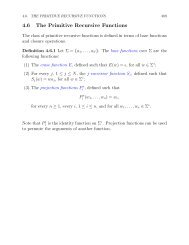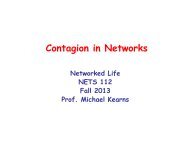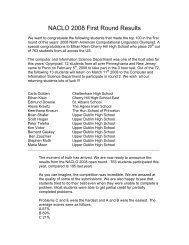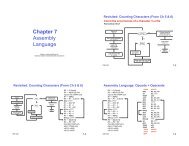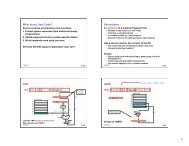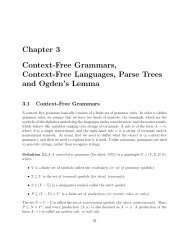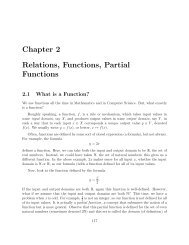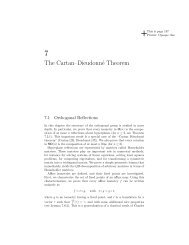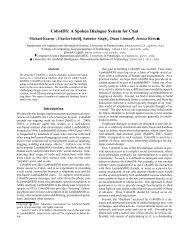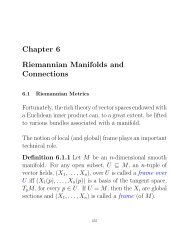But first, a primer on IP Multicast Problems with IP Multicast ...
But first, a primer on IP Multicast Problems with IP Multicast ...
But first, a primer on IP Multicast Problems with IP Multicast ...
You also want an ePaper? Increase the reach of your titles
YUMPU automatically turns print PDFs into web optimized ePapers that Google loves.
Mesh-Based C<strong>on</strong>tent Routing using<br />
XML<br />
Paper by<br />
Alex C. Snoeren, Kenneth C<strong>on</strong>ley, and David K. Gifford<br />
SOSP '01<br />
Presented by<br />
Micah Sherr<br />
(<strong>with</strong> several slides from Alex Snoeren)<br />
January 25th, 2007<br />
<strong>Problems</strong> <strong>with</strong> <strong>IP</strong> <strong>Multicast</strong><br />
Packet loss problematic (reliability fixes<br />
often adds significant latency)<br />
Link/node failure cascades down multicast<br />
tree<br />
All subscribers receive same data stream<br />
Security and firewall issues<br />
Motivating Example:<br />
Air Traffic C<strong>on</strong>trol (ATC) Streams<br />
Diverse client requests<br />
− Flights below 30,000 feet<br />
− UAL flights taking off<br />
from PHL<br />
Time-critical data<br />
− Available runways for<br />
landing at NWK<br />
Little tolerance for loss<br />
− JetBlue134 heading<br />
towards flight path of<br />
NWA513<br />
<str<strong>on</strong>g>But</str<strong>on</strong>g> <str<strong>on</strong>g>first</str<strong>on</strong>g>, a <str<strong>on</strong>g>primer</str<strong>on</strong>g> <strong>on</strong> <strong>IP</strong> <strong>Multicast</strong><br />
Clients subscribe to multicast<br />
stream<br />
Routers <strong>on</strong>ly forward to<br />
interfaces which have<br />
subscribers (forms a routing<br />
tree)<br />
<strong>IP</strong>v4 addresses reserved for<br />
multicast<br />
− Global scope: 224.0.1.0-238.255.255.255<br />
− Limited scope: 239.0.0.0-239.255.255.255<br />
Protocols for group<br />
management (IGMP)<br />
Protocols for multicast delivery<br />
(PIM, DVMRP)<br />
Mesh-Based C<strong>on</strong>tent Routing using XML<br />
Reliably serve time-critical data streams<br />
Assumpti<strong>on</strong>s:<br />
− Time-critical data: low-latency more important<br />
than bandwidth<br />
− Clients interested in different c<strong>on</strong>tent<br />
− Network (Internet) is failure-pr<strong>on</strong>e and lossy<br />
Mesh-Based C<strong>on</strong>tent Routing using XML<br />
XML Routing: Packets tagged <strong>with</strong> XML<br />
descriptors<br />
− supports c<strong>on</strong>tent-based routing<br />
− publish/subscribe logic in the network<br />
Mesh-Based Overlay Network<br />
− redundancy == fault-tolerance<br />
− redundancy provides low-latency<br />
1
Root routers (R1,R2) produce<br />
c<strong>on</strong>tent (informati<strong>on</strong> providers)<br />
Internal routers (I1,I2,I3) are<br />
intermediary nodes in the<br />
network (redundancy<br />
providers)<br />
Clients (C1,C2,C3) are<br />
informati<strong>on</strong> c<strong>on</strong>sumers<br />
10,000 ft overview<br />
(no pun intended)<br />
I1<br />
C1<br />
R1<br />
I2<br />
C2<br />
I3<br />
R2<br />
C3<br />
XML Routing<br />
Root routers publish tagged<br />
XML data streams<br />
Clients subscribe to certain<br />
comp<strong>on</strong>ents<br />
Internal routers prune<br />
c<strong>on</strong>tent (logic in the<br />
network)<br />
− No need to forward data that<br />
isn't needed<br />
− Requires efficient XML<br />
parsing / querying (XQuery or<br />
XPath)<br />
ATC Stream XML Cost Overhead<br />
Raw Encoding:<br />
153014022245CCZVTZ UAL1021 512 290 4928N12003W<br />
XML Encoding:<br />
<br />
153014022245CCZVTZ<br />
<br />
UAL1021<br />
<br />
512<br />
290<br />
4928N12003W<br />
<br />
<br />
What about reliability?<br />
Handling Failure in the Network<br />
Comp<strong>on</strong>ent repair or replacement<br />
− Takes time to detect failure and identify<br />
replacement<br />
− Synchr<strong>on</strong>izing replacement takes additi<strong>on</strong>al time<br />
− Probably not ideal when JetBlue134 heading<br />
towards flight path of NWA513<br />
Redundancy<br />
− Redundant network comp<strong>on</strong>ents<br />
− Redundant data<br />
− Bandwidth and synchr<strong>on</strong>izati<strong>on</strong> overhead<br />
Bandwidth Cost<br />
− Use compressi<strong>on</strong> to mitigate XML bloat<br />
− XML ATC compresses 10X better than raw ATC data<br />
Processing Cost<br />
− Parsing XML and XPath query requires little overhead<br />
~ 65 usecs for parsing<br />
~ 5-15 usecs for query<br />
− Highly dependent <strong>on</strong> data stream<br />
I1<br />
C1<br />
R1<br />
uncompressed compressed<br />
Mesh Networks<br />
Leverage redundancy to achieve fault-tolerance<br />
and low-latency<br />
I2<br />
C2<br />
I3<br />
R2<br />
C3<br />
2
k-Resiliency<br />
Every node c<strong>on</strong>nected to k parents, receives<br />
duplicate packet stream from each parent<br />
If graph is acyclic, minimum cut of mesh is k<br />
− mesh resilient to (k-1) node or link failures<br />
Requirements for (k-1)-resilient mesh network:<br />
− acyclic<br />
− node needs k parents<br />
− paths to parents should be<br />
distinct<br />
I1 I2 I3<br />
Diversity C<strong>on</strong>trol Protocol (DCP)<br />
Reassembles packet streams from 1+ senders<br />
Applicati<strong>on</strong> Serial Numbers (ANs)<br />
− associated <strong>with</strong> packet c<strong>on</strong>tent, not sender<br />
− generated at root routers, remain identifiable throughout mesh<br />
− incremented <strong>with</strong> each packet<br />
DCP is a reliability protocol<br />
− retransmissi<strong>on</strong>s sent if missing AN detected<br />
− packets buffered and sent in-order at each<br />
hop<br />
Supports datagram and stream modes<br />
Coping <strong>with</strong> Loss<br />
If receiver timeouts waiting for next AN, it<br />
transmits NACK to all senders<br />
− Like TCP fast retransmit, timeout interval shorter if<br />
future AN received<br />
Senders resend up<strong>on</strong> receiving NACK<br />
Assuming independence of sender failures,<br />
probability of loss is f k<br />
Senders periodically request ACKs from clients<br />
− limits queuing<br />
− achieves rapid resynchr<strong>on</strong>izati<strong>on</strong><br />
C1<br />
Low Latency through Redundancy<br />
Three ways to improve<br />
latency:<br />
− Increase speed of light<br />
(hard to do)<br />
− Use forward error correcti<strong>on</strong><br />
(losses come in bursts)<br />
− Use redundancy (bandwidth<br />
overhead)<br />
Redundancy reduces<br />
latency by<br />
− Using <str<strong>on</strong>g>first</str<strong>on</strong>g> arriving packet<br />
− Prevents need for<br />
retransmissi<strong>on</strong>s<br />
DCP<br />
Input<br />
XML<br />
Switch<br />
Output<br />
DCP<br />
A B<br />
Putting it all together:<br />
The XML Router<br />
Link<br />
Queries Link<br />
Queries Link<br />
Queries Link<br />
Queries Link<br />
Queries<br />
Input DCP comp<strong>on</strong>ent<br />
3<br />
1<br />
C<br />
− Maintain parent set<br />
− Assemble data stream<br />
XML Switch<br />
1<br />
2<br />
3<br />
1<br />
3<br />
2<br />
− Parse incoming XML stream<br />
− Route XML packets based <strong>on</strong><br />
link queries<br />
Output DCP comp<strong>on</strong>ent<br />
− Manage client subscripti<strong>on</strong>s<br />
− Package and distribute XML<br />
streams to clients<br />
Mesh Formati<strong>on</strong> and Maintenance:<br />
Adding Routers and Clients<br />
1. Initialize set S to be root routers<br />
2. For each node in S, send join request and<br />
remove node from S<br />
a. If node accepts join, add it to parent set P. If |P|=k,<br />
stop.<br />
b. If node rejects join, ask it for a list of its children,<br />
and add them to S.<br />
3. If |S|>0, goto 2.<br />
3
Mesh Formati<strong>on</strong> and Maintenance:<br />
Mesh Repair<br />
If parent fails, node attempts to join new parent<br />
Must preserve acyclic mesh:<br />
− routers keep level that is <strong>on</strong>e greater than all of its<br />
parents<br />
− during recovery, node N will join P if N level < P level<br />
Recovers (k-1) resilience<br />
Results in mesh that flattens out<br />
over time<br />
Mesh approach outperforms TCP and<br />
erasure codes<br />
Summary<br />
Certain applicati<strong>on</strong>s require low-latency reliable<br />
multicast<br />
XML Routing enables flexible c<strong>on</strong>tent-based routing<br />
Mesh-based Overlay Networks provide both faulttolerance<br />
and low-latency<br />
Evaluati<strong>on</strong><br />
Implemented small mesh (6 nodes)<br />
Key findings:<br />
− Redundancy reduces loss exp<strong>on</strong>entially<br />
− Redundancy reduces average latency<br />
Some limitati<strong>on</strong>s<br />
AN Generati<strong>on</strong>: AN sequences from different<br />
root routers must be identical<br />
− Make ANs partially-ordered; each root router has its<br />
own sequence; client performs synchr<strong>on</strong>izati<strong>on</strong><br />
− block fingerprint matching<br />
Flow C<strong>on</strong>trol: Bandwidth/latency differ at<br />
various points in the mesh<br />
Large jitter could require the use of ACKs:<br />
results in ACK implosi<strong>on</strong><br />
Questi<strong>on</strong>s?<br />
?<br />
4


